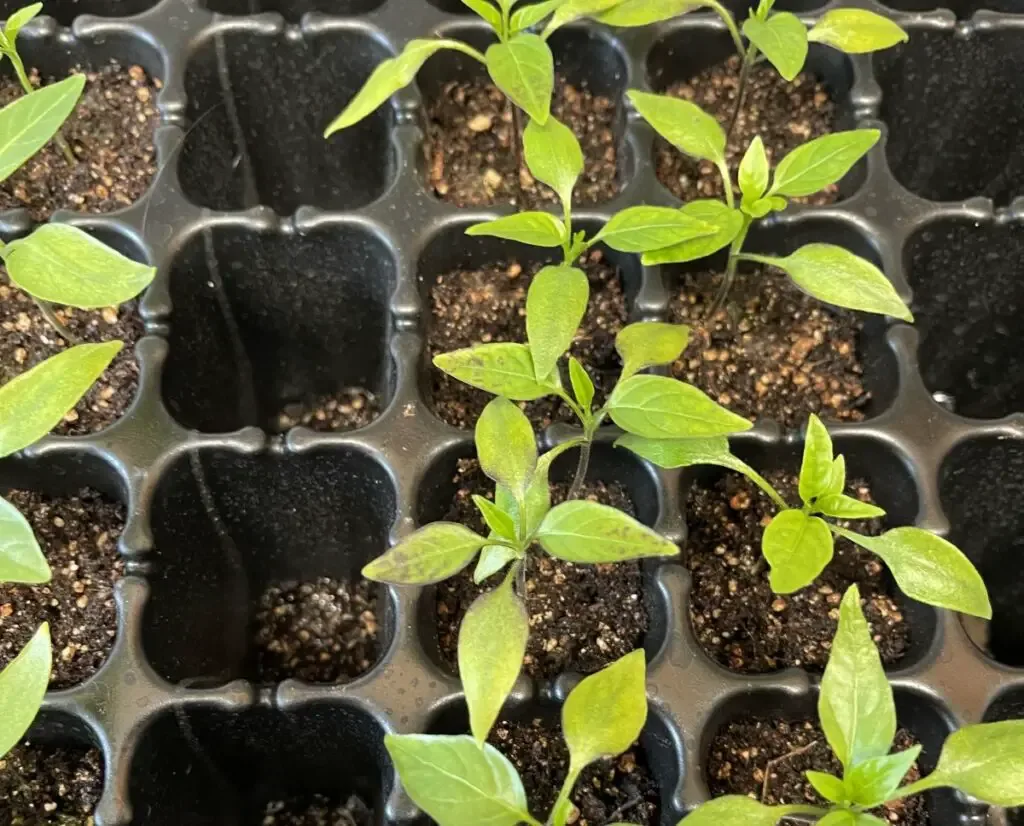When Peter Piper picked that famous peck of purple peppers, what color were the leaves of the pepper plant he picked them from?
While some ornamental pepper plants always have purple leaves, the leaves of most healthy, thriving pepper plants are vibrant green. When the color purple shows up in the foliage of a pepper plant that should have green leaves, it reveals a nutrient imbalance or other environmental stress.
Thankfully, the underlying cause of purple pepper leaves is usually easy to correct. In this post, we’ll look at six reasons pepper plants develop purple leaves and how to bring your purple pepper plant back to health.

Why Do Pepper Plants Have Purple Leaves?
A pigment called anthocyanin is responsible for the purple color in the leaves of pepper plants. When anthocyanin concentrations increase in pepper leaves it causes them to turn purple for one of the following reasons:
- Cold soil temperature
- Nutrient imbalance caused by wrong soil pH
- Genetic factors
- Too much environmental light or heat
- Disease or pest infestation
- Water stress
1. Soil Temperature Too Cold / Phosphorus Deficiency.
The most common reason pepper plant leaves turn purple is phosphorus deficiency caused by cold soil temperatures.
We interviewed a pepper grower at a commercial greenhouse when writing this post. When we asked her why pepper leaves turn purple, her immediate answer was, “they’re too cold!” She described how, in her greenhouse, the outer rows of peppers grown next to the greenhouse walls where there’s more heat loss would turn purple, while the leaves on the same crop at the center of the greenhouse would stay bright green.
In our home garden, too, we’ve observed leaves on pepper plants (as well as on other nightshade crops like eggplant and tomato) turn purple when we set them out too early in the spring.
But why does this happen?
Why Do Pepper Leaves Turn Purple in the Cold?
The reason why cold soil temperatures cause pepper leaves to turn purple is related to the nutrient phosphorus.
Phosphorus is necessary for photosynthesis, cell replication, and energy transfer in plants. Plants use phosphorus to produce ATP (adenosine triphosphate), the primary energy source for all living cells. In simple terms: plants can’t grow without adequate phosphorus.
But phosphorus is a heavy molecule and does not move around much in the soil. This means plant roots must branch out and search for the phosphorus they need. Cold soil stunts root growth, which leads to a decreased uptake of phosphorus.
With less phosphorus comes less ATP, less energy transfer throughout the plant, and a buildup of sugars containing anthocyanin in the leaves of pepper plants.
How to Fix Purple Pepper Leaves Caused by Cold Temperatures
There are two ways to avoid phosphorus deficiency in pepper plants. The first is to add a phosphorus-rich fertilizer (such as fish bone meal) to the base of a pepper seedling before setting it outdoors, so the roots won’t have to stretch very far to reach the phosphorus they need.
However, excess phosphorus in the soil creates other problems. It increases the total dissolved solids in the soil, making it harder for plants to uptake water and water-borne nutrients. Most soils contain all the phosphorus necessary to grow peppers. However, because phosphorus reacts with other nutrients like iron, calcium, and magnesium, the plant may be unable to access it.
So, rather than add a phosphorus-rich fertilizer, we recommend preventing phosphorus deficiency by not exposing your pepper plants to soil temperatures below 60 degrees Fahrenheit (15.5 degrees Celsius), night or day.
If the leaves on your pepper plant have already turned purple due to the cold, don’t worry! Just bring the plant back into a warm environment until nighttime temperatures increase. As the plant grows, the purple color will fade.
2. Other Nutrient Imbalances
Although phosphorus deficiency is the most common cause of purple leaves on pepper plants, other nutrient imbalances can also be responsible.
Without enough potassium and nitrogen, pepper plants won’t photosynthesize efficiently and won’t move sugars formed in the leaves to the new growth or fruit. This causes a buildup of sugars in the leaves that contain purple pigment.
Again, the way to fix pepper leaves that turned purple due to inadequate nutrients isn’t necessarily to add more fertilizer. Pepper seedlings are more susceptible to turning purple than adult plants, but heavy fertilizer can burn seedlings that aren’t yet ready to flower.
Most likely, your soil already contains plenty of nutrients for seedlings. But you could have a less-than-ideal soil pH that affects nutrients’ availability.
Peppers grow best in loamy, slightly acidic soil with a pH range of 6.0 to 6.5. Test your soil and water acidity and the soil’s NPK (nitrogen, phosphorus, and potassium) levels before adding more fertilizer to your pepper plants.

3. Too Much Blue or UV Light
After nutrient deficiency, the next most common cause of purple leaves in pepper plants is too much light, specifically too much blue light or ultraviolet (UV) light.
Blue light, which is next to UV light on the spectrum, plays an important role in photosynthesis. But too much of it can damage plants, especially seedlings.
When a pepper plant is exposed to more blue light or UV light than it needs, it produces anthocyanin to protect itself. This dark purple pigment acts like a suntan in humans, blocking the absorption of blue light or UV light. While this helps to protect the plant from the harsh light, it can delay the ripening of certain peppers.
Anthocyanin is also a potent antioxidant. It binds with free radicals that cause UV damage and removes them from the pepper plant.
In our gardening experience, we’ve seen Bell pepper and hot pepper seedlings turn purple after we left LED grow lights on overnight. We’ve also seen leaves on older plants develop deep purple or black patches where they have direct contact with an LED grow light.
To prevent purple leaves caused by too much light:
- Hang your grow lights at the manufacturer’s recommended height for each stage of plant development.
- Keep grow lights on for only 8-12 hours a day, followed by a period of darkness.
- If you live in an area with long days and intense sunlight, provide shade cloths for your peppers that are growing outdoors.
4. Genetic Factors
If you see your pepper plant developing purple leaves, check your seed packet! In some varieties of peppers, purple leaves are a normal development due to the plant’s genetics, and are not a problem.
Most varieties of peppers that genetically produce purple leaves are ornamental, but there are a few that are edible.
Varieties of peppers that produce purple leaves due to genetics include Posh Peppers, Purple Flash, Black Pearl, Royal Black, and Pimenta de Neyde.
If you (or your neighbors) grow any of these purple-leaved varieties, these purple varieties could cross-pollinate your varieties with green leaves. If you save the cross-pollinated seeds and grow them, they may produce pepper plants with purple or partially purple leaves.
5. Diseases or Pest Infestation
A handful of common diseases and pests can cause pepper leaves to develop purple patches or spots.
Bacterial Leaf Spot is a common pepper disease characterized by dark purple or brown circular lesions on leaves. Once a plant is infected with Bacterial Leaf Spot, it’s very difficult to treat. However, you can prevent this disease if you practice good biosecurity in your garden, avoid overwatering, select resistant varieties, and treat early with a copper solution.
Tobacco Mosaic Virus (TMV) is a disease that causes purple patches on pepper plant leaves. It’s carried in plant sap and usually spreads via infected tools or seeds. Unfortunately, there is no effective treatment for Tobacco Mosaic Virus. Experts recommend destroying affected plants and thoroughly disinfecting all gloves and tools to avoid spreading the disease.
If the purple patches on your pepper leaves don’t fit the pattern of any specific disease, they could be a response to pest pressure or a combination of minor stressors.

6. Water Stress
Because anthocyanin is an antioxidant that helps plants overcome harsh conditions, pepper plants produce this pigment to respond to many kinds of stress, including over-watering or drought.
In fact, horticulture professor Linda Chalker-Scott of Washington State University suggests that anthocyanins not only help plants deal with stress by removing free radicals, but have direct osmoregulation functions in leaf tissues.
In simple terms, this means that if your pepper plant receives too much or too little water, it may produce anthocyanins—or pigments that turn its leaves purple—to regulate water use in the leaves.
If you think it’s unlikely that the previous items on this list caused your pepper leaves to turn purple, then look at your watering habits. The soil in your pepper pots should dry to at least 1 inch before you water them again, but don’t let them dry out to the point of wilting. Watering deeply but less frequently is better than watering lightly and too often.
Frequently Asked Questions
How Do You Keep Pepper Leaves from Turning Purple?
If the genetics of your pepper plants dictate that they should have green leaves when healthy, you can prevent the leaves from turning purple by avoiding stress to your pepper plant. Do this by taking the following steps:
- Don’t set your peppers outside in temperatures below 60 degrees Fahrenheit (15.5 degrees Celsius).
- Plant peppers in rich, loamy soil with lots of organic matter and a balanced pH.
- Water deeply but not too often.
- Practice good biosecurity and inspect your plants regularly for diseases and pests.
Why Does My Pepper Plant Have Purple Stems?
It’s common for the stems of many varieties of pepper plants to turn purple at the branch and leaf nodes. This is a sign of healthy growth and not a concern or sign of disease.
Closing Thoughts
Pepper plants turn purple when environmental pressure, nutrient deficiency, or genetics cause a buildup of anthocyanin pigment in the leaves. Scientists have discovered many wonderful functions of anthocyanins in plants; your pepper plant probably produced this rich and striking color, not because it’s about to die, but to help it thrive in stressful conditions.
In most cases, you can correct purple leaves by adjusting the fertilizer, water, or lighting your plant receives. Once corrections are made, your pepper plant will typically grow out of its purple color and go on to produce healthy fruit.
